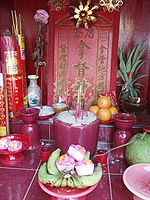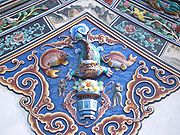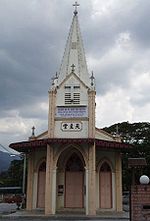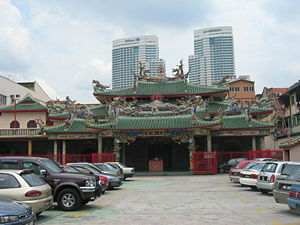
Malaysian Chinese religion
Encyclopedia

China
Chinese civilization may refer to:* China for more general discussion of the country.* Chinese culture* Greater China, the transnational community of ethnic Chinese.* History of China* Sinosphere, the area historically affected by Chinese culture...
origin as practiced by the sizable Chinese minority of Malaysia. These beliefs and practices are heavily influenced by the three faiths practiced by Chinese communities, Confucianism
Confucianism
Confucianism is a Chinese ethical and philosophical system developed from the teachings of the Chinese philosopher Confucius . Confucianism originated as an "ethical-sociopolitical teaching" during the Spring and Autumn Period, but later developed metaphysical and cosmological elements in the Han...
, Buddhism
Buddhism
Buddhism is a religion and philosophy encompassing a variety of traditions, beliefs and practices, largely based on teachings attributed to Siddhartha Gautama, commonly known as the Buddha . The Buddha lived and taught in the northeastern Indian subcontinent some time between the 6th and 4th...
, and Taoism
Taoism
Taoism refers to a philosophical or religious tradition in which the basic concept is to establish harmony with the Tao , which is the mechanism of everything that exists...
.
According to The Encyclopedia of Malaysia, vol. Religions & Beliefs, statistics from the 2000 census indicate that around 20% of the population, mainly Malaysian Chinese
Malaysian Chinese
Malaysian Chinese is a Malaysian of Chinese origin. Most are descendants of Chinese who arrived between the fifteenth and the mid-twentieth centuries. Within Malaysia, they are usually simply referred to as "Chinese" in all languages. The term Chinese Malaysian is also sometimes used to refer to...
, are Buddhist and a further 3% follow Chinese religions including Confucianism and Taoism. The Chinese folk beliefs
Chinese folk religion
Chinese folk religion or Shenism , which is a term of considerable debate, are labels used to describe the collection of ethnic religious traditions which have been a main belief system in China and among Han Chinese ethnic groups for most of the civilization's history until today...
in Malaysia include beliefs in local guardian spirits which originated from traditional animism
Animism
Animism refers to the belief that non-human entities are spiritual beings, or at least embody some kind of life-principle....
and mysticism
Mysticism
Mysticism is the knowledge of, and especially the personal experience of, states of consciousness, i.e. levels of being, beyond normal human perception, including experience and even communion with a supreme being.-Classical origins:...
, and the worship of sacred monks and spirits popular among the Thais
Thai people
The Thai people, or Siamese, are the main ethnic group of Thailand and are part of the larger Tai ethnolinguistic peoples found in Thailand and adjacent countries in Southeast Asia as well as southern China. Their language is the Thai language, which is classified as part of the Kradai family of...
, also elevated local heroes and leaders to patron saints and guardians.
History

Hoklo people
The Hoklo people are Han Chinese people whose traditional Ancestral homes are in southern Fujian of South China...
traders, but it was not until the 19th century that there was a mass migration of Chinese. They built shrines dedicated to their deities and cemeteries for those who died. The Chinese migration
Chinese migration
Waves of Chinese emigration have happened throughout history. The mass emigration known as the Chinese Diaspora, which occurred from the 19th century to 1949, was mainly caused by wars and starvation in mainland China, as well as the problems resulting from political corruption...
during the tin and gold mining days, which were a result of high demand for these products, prompted the need of temples, for practices and religious rituals. During that time, most immigrants were illiterate or poorly educated peasants and coolies, thus Buddhist and Taoist monks were brought over from China
China
Chinese civilization may refer to:* China for more general discussion of the country.* Chinese culture* Greater China, the transnational community of ethnic Chinese.* History of China* Sinosphere, the area historically affected by Chinese culture...
to run the temples.
Social organizations in the Chinese immigrant society were important, where surnames, dialect, locality and trade mattered. The Cantonese
Cantonese people
The Cantonese people are Han people whose ancestral homes are in Guangdong, China. The term "Cantonese people" would then be synonymous with the Bun Dei sub-ethnic group, and is sometimes known as Gwong Fu Jan for this narrower definition...
, Hokkien
Hoklo people
The Hoklo people are Han Chinese people whose traditional Ancestral homes are in southern Fujian of South China...
, Teochew
Teochew people
The Chaozhou people are Han people, native to the Chaoshan region of eastern Guangdong province of China who speak the Teochew dialect. Today, most Teochew people live outside China in Southeast Asia especially in Singapore, Thailand, and Malaysia. They can also be found almost anywhere in the...
and Hakka
Hakka people
The Hakka , sometimes Hakka Han, are Han Chinese who speak the Hakka language and have links to the provincial areas of Guangdong, Jiangxi, Guangxi, Sichuan, Hunan and Fujian in China....
, respectively formed their secret societies, such as the Ghee Hin and Hai San, and they played as 'government' in controlling the Chinese immigrants. Local Malay
Malay people
Malays are an ethnic group of Austronesian people predominantly inhabiting the Malay Peninsula, including the southernmost parts of Thailand, the east coast of Sumatra, the coast of Borneo, and the smaller islands which lie between these locations...
chiefs called the Chinese leaders Kapitan Cina (literally, "Captain China" or "Chinese Captain"), who soon became patron saints of the Chinese. The evolution of Malaysian Chinese Religion was a mixture of local value and belief systems, where it produced some local deities such as the Na Tuk Kong
Na Tuk Kong
Na Tuk Kong are local guardian spirits in Malaysia. One derivation of the name unites Dato or Datuk from the local Malay word for 'grandfather', which is used as an honorific, combined with Kong from the Malaysian Chinese, also used as an honorific...
and Tua Pek Kong
Tua Pek Kong
Tua Pek Kong , literally means "Grand Uncle", is one of the pantheon of Malaysian Chinese Gods. It was believed the date Tua Pek Kong arrived in Penang was 40 years before Francis Light in 1746.Tua Pek Kong was a man named Zhang Li from the Hakka clan...
.

Christianity
According to the Encyclopedia of Malaysia, there are records where PersianPersian people
The Persian people are part of the Iranian peoples who speak the modern Persian language and closely akin Iranian dialects and languages. The origin of the ethnic Iranian/Persian peoples are traced to the Ancient Iranian peoples, who were part of the ancient Indo-Iranians and themselves part of...
and Turkish
Turkic peoples
The Turkic peoples are peoples residing in northern, central and western Asia, southern Siberia and northwestern China and parts of eastern Europe. They speak languages belonging to the Turkic language family. They share, to varying degrees, certain cultural traits and historical backgrounds...
traders with Nestorian Christian origins came around the year 650 CE, but it was not until the conquest of Malacca
Malacca
Malacca , dubbed The Historic State or Negeri Bersejarah among locals) is the third smallest Malaysian state, after Perlis and Penang. It is located in the southern region of the Malay Peninsula, on the Straits of Malacca. It borders Negeri Sembilan to the north and the state of Johor to the south...
by the Portuguese
Portugal
Portugal , officially the Portuguese Republic is a country situated in southwestern Europe on the Iberian Peninsula. Portugal is the westernmost country of Europe, and is bordered by the Atlantic Ocean to the West and South and by Spain to the North and East. The Atlantic archipelagos of the...
in year 1511, that marked the introduction of Roman Catholicism. The Dutch colonial year of 1641 brought in Protestantism
Protestantism
Protestantism is one of the three major groupings within Christianity. It is a movement that began in Germany in the early 16th century as a reaction against medieval Roman Catholic doctrines and practices, especially in regards to salvation, justification, and ecclesiology.The doctrines of the...
, and with the influx of Chinese and India
India
India , officially the Republic of India , is a country in South Asia. It is the seventh-largest country by geographical area, the second-most populous country with over 1.2 billion people, and the most populous democracy in the world...
n immigrants during the 19th century, more Christian missionaries were imported. However there were small numbers of Chinese Christians
Christianity in China
Christianity in China is a growing minority religion that comprises Protestants , Catholics , and a small number of Orthodox Christians. Although its lineage in China is not as ancient as the institutional religions of Taoism and Mahayana Buddhism, and the social system and ideology of...
, before the migration to Malaya
Malay Peninsula
The Malay Peninsula or Thai-Malay Peninsula is a peninsula in Southeast Asia. The land mass runs approximately north-south and, at its terminus, is the southern-most point of the Asian mainland...
.
Islam
In the TerengganuTerengganu
Terengganu is a sultanate and constitutive state of federal Malaysia. The state is also known by its Arabic honorific, Darul Iman...
state, Jeram and Tepoh were two of the traditional Chinese-Muslim villages; their forefathers arrived together with Zheng He
Zheng He
Zheng He , also known as Ma Sanbao and Hajji Mahmud Shamsuddin was a Hui-Chinese mariner, explorer, diplomat and fleet admiral, who commanded voyages to Southeast Asia, South Asia, the Middle East, and East Africa, collectively referred to as the Voyages of Zheng He or Voyages of Cheng Ho from...
or much earlier. Dato' Haji Mustapha Ma Qi is among the well-known Malaysian Chinese-Muslims. He is the president of the Chinese Muslim Association (MACMA - Persatuan Cina Muslim Malaysia). According to the official census, there were about 40,000 Chinese Muslims in Malaysia as of 2000, mostly converts by request of Malay Muslim family-in-law..
The Chinese acceptance of Islam
Islam
Islam . The most common are and . : Arabic pronunciation varies regionally. The first vowel ranges from ~~. The second vowel ranges from ~~~...
as a religion can be traced back as early as the 7th century, from the Chinese Muslims' annals and the history of Islam in China
Islam in China
Throughout the history of Islam in China, Chinese Muslims have influenced the course of Chinese history. Chinese Muslims have been in China for the last 1,400 years of continuous interaction with Chinese society...
. Guangzhou
Guangzhou
Guangzhou , known historically as Canton or Kwangchow, is the capital and largest city of the Guangdong province in the People's Republic of China. Located in southern China on the Pearl River, about north-northwest of Hong Kong, Guangzhou is a key national transportation hub and trading port...
city has one of the earliest mosques, Huaisheng Mosque
Huaisheng Mosque
The Huaisheng Mosque, also known as the Lighthouse Mosque, is the main mosque of Guangzhou.Rebuilt many times over its history, it is traditionally thought to have been originally built over 1,300 years ago, which would make it one of the oldest mosques in the world. It was named in memory of...
. Today in China, there are about over 20 million Muslims. They can be identified by their surnames, especially Ma, Li, Chang, Zhang, Lan, Wu, Mi, Yang, etc. The famous Ma Shan Bao (Zheng He
Zheng He
Zheng He , also known as Ma Sanbao and Hajji Mahmud Shamsuddin was a Hui-Chinese mariner, explorer, diplomat and fleet admiral, who commanded voyages to Southeast Asia, South Asia, the Middle East, and East Africa, collectively referred to as the Voyages of Zheng He or Voyages of Cheng Ho from...
) was a friend of Parameswara , the ruler of Melaka in 1402.
Malaysian Chinese Deities
The name of deities listed here does not represent ChineseHan Chinese
Han Chinese are an ethnic group native to China and are the largest single ethnic group in the world.Han Chinese constitute about 92% of the population of the People's Republic of China , 98% of the population of the Republic of China , 78% of the population of Singapore, and about 20% of the...
of The People's Republic of China. However the Deities listed here were tradition passed down from ancestors living in ancient China. Na Tuk Kong
Na Tuk Kong
Na Tuk Kong are local guardian spirits in Malaysia. One derivation of the name unites Dato or Datuk from the local Malay word for 'grandfather', which is used as an honorific, combined with Kong from the Malaysian Chinese, also used as an honorific...
, in particular, was a localized Deity where the name derived from 'Dato', which is a local Malay
Malay language
Malay is a major language of the Austronesian family. It is the official language of Malaysia , Indonesia , Brunei and Singapore...
word.
List of Malaysian Chinese Gods:
- Na Tuk KongNa Tuk KongNa Tuk Kong are local guardian spirits in Malaysia. One derivation of the name unites Dato or Datuk from the local Malay word for 'grandfather', which is used as an honorific, combined with Kong from the Malaysian Chinese, also used as an honorific...
(Chinese : 拿督公) - Celestial GodJade EmperorThe Jade Emperor in Chinese folk culture, is the ruler of Heaven and all realms of existence below including that of Man and Hell, according to a version of Taoist mythology. He is one of the most important gods of the Chinese traditional religion pantheon...
Tnee Kong (Chinese : 天公) - Earth GodTu Di GongTu Di Gong , also known as Tu Di , Tu Gong , and Dabo Gong , is a Chinese earth god worshipped by Chinese folk religion worshippers and Taoists. A formal name for Tu Di Gong is , meaning the earth god of wealth and merit....
Teh Choo Kong (地主公), Tu Di Gong (Chinese : 土地公) - Tua Pek KongTua Pek KongTua Pek Kong , literally means "Grand Uncle", is one of the pantheon of Malaysian Chinese Gods. It was believed the date Tua Pek Kong arrived in Penang was 40 years before Francis Light in 1746.Tua Pek Kong was a man named Zhang Li from the Hakka clan...
(Chinese : 大伯公) - God of Prosperity Choy Sun Yeh / God of Fortune (Chinese : 财神)
- Kwan GodGuan YuGuan Yu was a general serving under the warlord Liu Bei during the late Eastern Han Dynasty of China. He played a significant role in the civil war that led to the collapse of the Han Dynasty and the establishment of the state of Shu Han during the Three Kingdoms period, of which Liu Bei was the...
Kwan Kong (Chinese : 關公) - Kuan YinKuan YinGuanyin is the bodhisattva associated with compassion as venerated by East Asian Buddhists, usually as a female. The name Guanyin is short for Guanshiyin which means "Observing the Sounds of the World". She is also sometimes referred to as Guanyin Pusa...
originated from Sanskrit AvalokiteśvaraAvalokitesvaraAvalokiteśvara is a bodhisattva who embodies the compassion of all Buddhas. He is one of the more widely revered bodhisattvas in mainstream Mahayana Buddhism....
(Chinese : 觀世音), commonly known as the Goddess of Mercy. - Ma Zu (Chinese : 媽祖) is the Taoist Goddess of the Sea who protects fishermen and sailors.
- Di Zhu God (Chinese: 地主神) Lord of the Land Used.
Material suppliers
Malaysian Chinese Gods is also a thriving business in Malaysia, there are large numbers of suppliers and shops specialize in the materials of local Malaysian Chinese beliefs, such as joss sticks, dead people's money (Hell moneyHell Money
"Hell Money" is a 1996 episode of The X-Files television series. It was the nineteenth episode broadcast in the show's third season. "Hell Money" features Mulder and Scully investigating a Chinese lottery involving the selling of body parts.- Plot :...
), etc., they are commonly known as Gods Material Shop
Gods Material Shop
A prayer material shop is a shop specializing in supplying materials used in the practice of Shenism, Taoism and Chinese Buddhism.These shops are abundant in Chinese areas, from Mainland China, Hong Kong, Taiwan, Singapore, to Malaysia , and several Chinatowns.-Items for...
(Chinese : 神料商店).
List of Malaysian Chinese religions

- BuddhismBuddhismBuddhism is a religion and philosophy encompassing a variety of traditions, beliefs and practices, largely based on teachings attributed to Siddhartha Gautama, commonly known as the Buddha . The Buddha lived and taught in the northeastern Indian subcontinent some time between the 6th and 4th...
- TaoismTaoismTaoism refers to a philosophical or religious tradition in which the basic concept is to establish harmony with the Tao , which is the mechanism of everything that exists...
- ConfucianismConfucianismConfucianism is a Chinese ethical and philosophical system developed from the teachings of the Chinese philosopher Confucius . Confucianism originated as an "ethical-sociopolitical teaching" during the Spring and Autumn Period, but later developed metaphysical and cosmological elements in the Han...
- Ancestor worship
- Superstition of Malaysian ChineseSuperstition of Malaysian ChineseSuperstitions of Malaysian Chinese refers to traditional superstitious beliefs of Malaysian Chinese .-"Sacred" stone attraction:...
- Fengshui
- ProtestantismProtestantismProtestantism is one of the three major groupings within Christianity. It is a movement that began in Germany in the early 16th century as a reaction against medieval Roman Catholic doctrines and practices, especially in regards to salvation, justification, and ecclesiology.The doctrines of the...
- CatholicismCatholicismCatholicism is a broad term for the body of the Catholic faith, its theologies and doctrines, its liturgical, ethical, spiritual, and behavioral characteristics, as well as a religious people as a whole....
- IslamIslamIslam . The most common are and . : Arabic pronunciation varies regionally. The first vowel ranges from ~~. The second vowel ranges from ~~~...
- I-Kuan TaoI-Kuan TaoI-Kuan Tao, also Yīguàn Dào, or usually initialized as IKT is a new religious movement that originated in twentieth-century China. It incorporates elements from Confucianism, Taoism, and Chinese Buddhism, and recognizes the validity of non-Chinese religious traditions such as Christianity and...
- De Jiao (Moral Uplifting Society)
See also
- Chinese religionChinese religionChinese religion may refer to:*Religion in China*Religion in Republic of China*Chinese folk religion*East Asian religions...
- Ancestor worship
- Superstition of Malaysian ChineseSuperstition of Malaysian ChineseSuperstitions of Malaysian Chinese refers to traditional superstitious beliefs of Malaysian Chinese .-"Sacred" stone attraction:...
- Fengshui
- Chinese folk religionChinese folk religionChinese folk religion or Shenism , which is a term of considerable debate, are labels used to describe the collection of ethnic religious traditions which have been a main belief system in China and among Han Chinese ethnic groups for most of the civilization's history until today...
- Chinese mythologyChinese mythologyChinese mythology is a collection of cultural history, folktales, and religions that have been passed down in oral or written tradition. These include creation myths and legends and myths concerning the founding of Chinese culture and the Chinese state...
- list of deities
- Gods Material ShopGods Material ShopA prayer material shop is a shop specializing in supplying materials used in the practice of Shenism, Taoism and Chinese Buddhism.These shops are abundant in Chinese areas, from Mainland China, Hong Kong, Taiwan, Singapore, to Malaysia , and several Chinatowns.-Items for...

